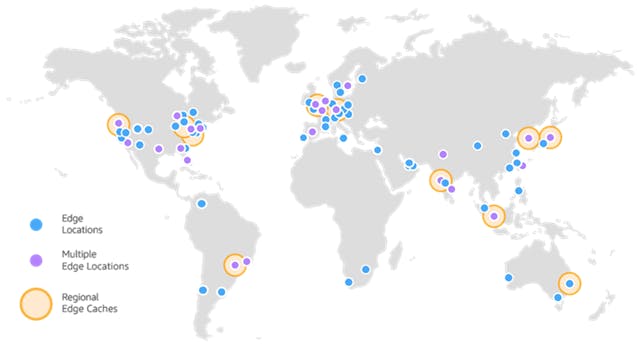What is Amazon CloudFront?
4 min read

CDN stands for Content Delivery Network. It is a distributed network of servers strategically located across various geographical locations to deliver web content more efficiently to users. The primary purpose of a CDN is to reduce latency, improve website performance, and enhance the overall user experience.
How does CDN work?
Content Replication: When a website is integrated with a CDN, its static files (such as images, CSS, JavaScript, videos, etc.) are cached and replicated across multiple servers in different locations around the world.
Proximity to Users: When a user requests access to a webpage or content, the CDN system determines the user's location through their IP address. It then serves the requested content from the server closest to the user, minimizing the distance the data needs to travel.
Load Balancing: CDNs distribute incoming traffic across multiple servers, which helps to balance the load on the network. This ensures that no single server gets overwhelmed with requests, reducing the risk of downtime and improving overall performance.
Caching: CDNs cache static content at various points of presence (PoPs) around the world. When a user requests a piece of content that's already been cached, the CDN can deliver it quickly without needing to retrieve it from the origin server, further reducing latency.
Security: Many CDNs offer security features such as DDoS (Distributed Denial of Service) protection, Web Application Firewall (WAF), and SSL/TLS encryption. These features help to mitigate security threats and safeguard websites and web applications from attacks.
What is Amazon CloudFront?

AWS CloudFront is a content delivery network (CDN) service provided by Amazon Web Services (AWS). It helps deliver static and dynamic web content, including websites, images, videos, applications, APIs, and other assets, to users globally with low latency and high transfer speeds. Here's how AWS CloudFront works and its key features:
Edge Locations: CloudFront stores cached copies of your website's content across a massive network of edge locations around the globe. When a user requests your website, CloudFront delivers the content from the edge location closest to them, significantly reducing the distance the data needs to travel.
Integration with AWS Services: CloudFront seamlessly integrates with other AWS services like Amazon S3 (Simple Storage Service), EC2 (Elastic Compute Cloud), Lambda@Edge, and AWS Shield for optimized content delivery, storage, and security.
Reduced Latency: By serving content from nearby edge locations, CloudFront minimizes latency, the time it takes for the first byte of data to reach the user's device. This translates to faster loading times for your website.
Scalability: CloudFront automatically scales to meet the demands of your traffic. So, if you experience a sudden surge in visitors, CloudFront can handle it without any issues.
Security: CloudFront offers a variety of security features, including DDoS protection, SSL/TLS encryption, field-level encryption, and AWS Web Application Firewall (WAF), to secure your content and applications from various online threats.
Cost-Effective Pricing Model: CloudFront follows a pay-as-you-go pricing model, where you pay only for the data transfer and requests made through the CDN. AWS also offers pricing tiers and discounts for high-volume usage.
Real-Time Monitoring and Analytics: CloudFront offers detailed logs and real-time metrics through Amazon CloudWatch, enabling you to monitor the performance and usage of your content delivery in real-time.
Customization and Personalization: CloudFront provides options for customizing content delivery based on user locations, device types, and other factors using features like Lambda@Edge, which allows you to execute custom code at edge locations.
Conclusion
Overall, AWS CloudFront is a powerful CDN solution that helps businesses improve the performance, scalability, and reliability of their web applications and content delivery while providing robust security features and global reach.
